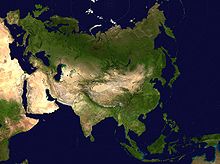- Supercontinent
-
 Animation of the rifting of Pangaea, an ancient supercontinent
Animation of the rifting of Pangaea, an ancient supercontinent
 The Eurasian supercontinent
The Eurasian supercontinent
In geology, a supercontinent is a landmass comprising more than one continental core, or craton. The assembly of cratons and accreted terranes that form Eurasia[1] qualifies as a supercontinent today.
Contents
History
Most commonly, paleogeographers employ the term supercontinent to refer to a single landmass consisting of all the modern continents. The earliest known supercontinent was Vaalbara. It formed from proto-continents and was a supercontinent by 3.1 billion years ago (3.1 Ga). Vaalbara broke up ~2.8 Ga ago. The supercontinent Kenorland was formed ~2.7 Ga ago and then broke sometime after 2.5 Ga into the proto-continent Cratons called Laurentia, Baltica, Australia, and Kalahari. The supercontinent Columbia or Nuna formed during a period of 2.0–1.8 billion years and broke up about 1.5–1.3 billion years ago.[2][3]
The supercontinent Rodinia formed about 1.1 billion years ago and broke up roughly 750 million years ago. One of the fragments included large parts of the continents now located in the southern hemisphere. Plate tectonics brought the fragments of Rodinia back together in a different configuration during the late Paleozoic era about 300 million years ago, forming the best-known supercontinent, Pangaea. Pangaea subsequently broke up into the northern and southern supercontinents, Laurasia and Gondwana, about 200 million years ago.
Mechanism of generation and dispersal
The continental lithosphere is 80–160 kilometres (50–99 mi) thick.[4]:94 When continents rift into separate plates, the thicker lithosphere gives way to thinner lithosphere of the oceans.[4]:94 Also, the transition from a continental rift to an oceanic rift is accompanied by block faulting, where blocks of continental crust drop down along extensional faults where the crust is being pulled apart.[4]:94 This results in a deep rift valley and a thinning of the crust.[4]:94 The African rift valley is an active rifting event. Rifting of a continent begins with hot-spot volcanism at rift valleys.[4]:94 Hot spots burn holes through the crust and cause it to weaken.[4]:94 The crust under a rift is only 30–50 kilometres (19–31 mi) thick.[4]:94
Because the continental crust is so much thicker than the oceanic crust, it conducts heat less efficiently, making it function like an insulating blanket.[4]:92 If a supercontinent covers a portion of the earth’s surface where heat from the mantle accumulates under the crust, it causes the land mass to dome upward.[4]:92 This creates a superswell.[4]:92 The continued bulging causes supercontinents to rift apart with individual, broken-off continents sliding off the superswell.[4]:92 The continents then move toward colder sinking regions in the mantle and become stranded over cool downflows of mantle rock.[4]:92 After the continents are separated, heat from the mantle is more easily conducted through the newly formed ocean basin.[4]:92 After so much heat has escaped, the continents halt their outward progress and begin to return to their places of origin.[4]:92
The landmasses surrounding the Pacific Basin apparently have not undergone continental collision.[4]:93 The Pacific Basin has narrowed and widened in response to the continental breakup dispersal and reconvergence in the area of the Atlantic Ocean.[4]:93 When today’s continents have reached their maximum dispersal (millions of years from now), the crust of the Atlantic Ocean bordering the continents will grow dense enough to sink into the mantle; creating subduction zones around the Atlantic Basin.[4]:93 This subduction into the mantle will begin the process of closing the Atlantic Basin.[4]:93 Eventually all continents will rejoin into another supercontinent over a large mantle downflow and the cycle of dispersal and rejoining will begin again.[4]:93
The cycle of rifting and patching repeats itself roughly every 450 million years.[4]:90
See also
References
- ^ And to a lesser extent, the Americas, if taken as a whole
- ^ Zhao, Guochun; Cawood, Peter A.; Wilde, Simon A.; Sun, M. (2002). "Review of global 2.1–1.8 Ga orogens: implications for a pre-Rodinia supercontinent". Earth-Science Reviews 59: 125–162. Bibcode 2002ESRv...59..125Z. doi:10.1016/S0012-8252(02)00073-9.
- ^ Zhao, Guochun; Sun, M.; Wilde, Simon A.; Li, S.Z. (2004). "A Paleo-Mesoproterozoic supercontinent: assembly, growth and breakup". Earth-Science Reviews 67: 91–123. doi:10.1016/j.earscirev.2004.02.003.
- ^ a b c d e f g h i j k l m n o p q r s t Erickson, Jon (1993). Craters, Caverns and Canyons – Delving Beneath the Earth’s Surface. ISBN 0-8160-2590-8.
External links
Continents Historical continentsArctica · Asiamerica · Atlantica · Avalonia · Baltica · Cimmeria · Congo craton · Euramerica · Kalaharia · Kazakhstania · Laurentia · North China · Siberia · South China · East Antarctica · IndiaSubmerged continents
Kerguelen Plateau · ZealandiaMythical and theorized continents
Atlantis · Kumarikkandam · Lemuria · Meropis · Mu · Terra AustralisSee also Regions of the worldCategories:- Continents
- Historical geology
- Supercontinents
Wikimedia Foundation. 2010.











